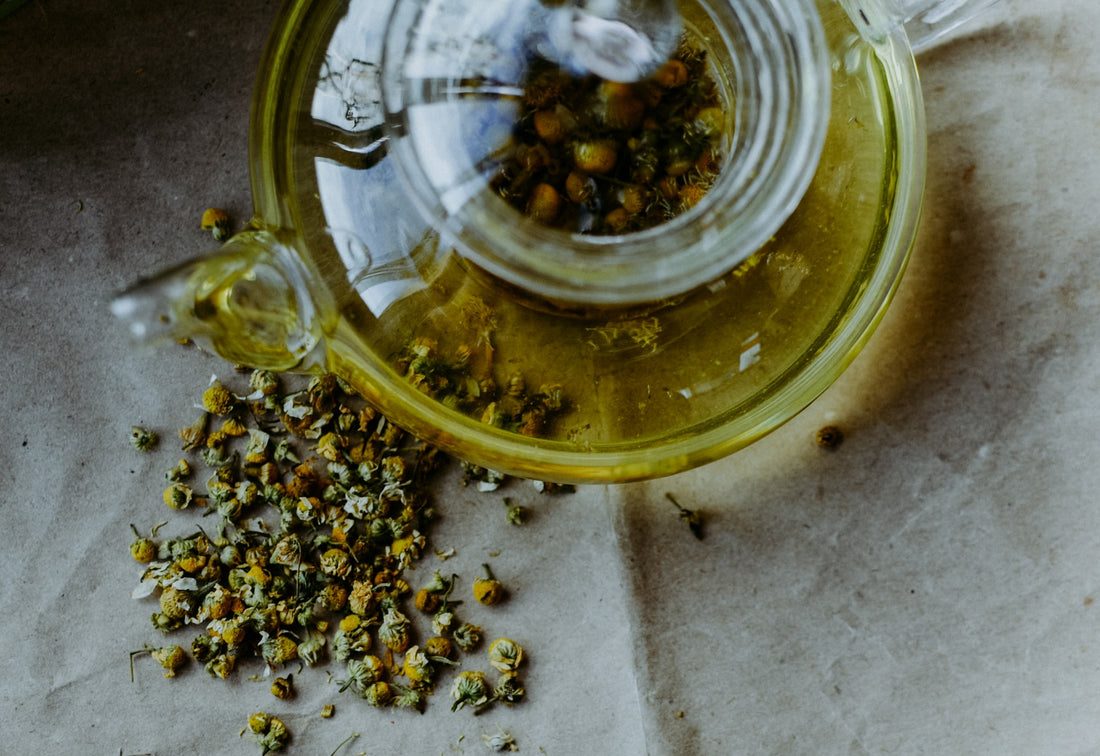Crafting tea blends is an enlightening experience. Herbs grown in your garden, whether used fresh or dried, are so much more potent than store bought combinations.
Tea made from fresh herbs is a different, richer experience. Dried herbs have a stronger taste since the flavor is concentrated. Fresh herbs are obviously fresher though they usually have a milder flavor profile. In fact, many fresh herbs taste quite different from their dried counterparts.
Use a combination of dried and fresh for a seriously potent tea blend!
Chamomile
This versatile flower can be grown outdoors in the spring or summer. It also can be grown indoors in the winter. Chamomile needs a minimum of 4 hours of indirect sunlight. This flower is an annual; harvest the flowers when it blooms.
Plant the seeds 1/4" deep in a 12" pot with suitable drainage holes. Chamomile needs temperatures of at least 68F to germinate. A heat mat or spot near the radiator will help a lot. When the seedlings have their second set of leaves, thin them to one every 2". Keep the soil moist yet not soggy. In 60-90 days, you'll have flowers to harvest.
Sage & Thyme
Sage and thyme plants are perennials in zones 5-8 and annuals in other locations. Plant the seeds in a pot that can be brought inside if needed. They are both drought-hardy, lightly frost-tolerant, and generally tough plants. In cold climates, the sage and thyme will go dormant in the winter. The plants can be brought inside at this point to continue growing.
Plant a few seeds 1/4" deep in a medium-size pot with drainage holes. To germinate, place the pots on a heat mat or put them on the windowsill. Once they have sprouted, place them near a sunny window to get at least 6 hours of light. Don't let them get direct light, though, or the leaves may burn.
Once the seedlings have 3 true leaves, thin the pots to just one plant. Sage and thyme plants will grow to the size of the pot they are in. They benefit from repotting every few years. Only water when the soil is dry to the first 1/2" of soil. Be careful not to overwater them.
Rosemary
This is a perennial that grows slow and sturdy and has wonderful, fragrant foliage. It makes the house smell wonderful. The rosemary shrub will expand to fit the pot you plant it in.
Because it is a perennial, rosemary can remain outdoors year-round in temperate climates. Alternately, it can be grown in a pot and overwintered indoors. Make sure rosemary plants get lots of sun and don't overwater them. They need a thorough watering only when the top 1/2" of soil is dry.
Mint, Catnip
Catnip and Mint are perennials in the same family, and their growing requirements are the same. For variety, peppermint, wintermint, or spearmint make great additions to herbal tea, as well.
All members of the mint family will spread all over a garden if you let them. Always plant them in pots. Sow seeds 1/4" deep in a pot with drainage holes. Place the pot on a heating mat to germinate or on a warm, sunny windowsill.
Once the seeds sprout, move them to an area with indirect light 6-8 hours a day. Mint can tolerate some shade. Keep soil evenly moist without letting it dry out but also not letting it get soggy. Harvest mint often to keep the plant looking its' best. The pots can be left outdoors or brought inside for continuous winter growing.
Lavender
A tall, bushy tender perennial, lavender will grow indoors or outdoors as long as it gets enough sun. The plants average between 1-3' in height, so be sure there is enough room for them to grow. Space outdoor plants 2-3' apart. Indoor plants need to be in a south-facing window for at least 8 hours of sunlight.
Lavender struggles in cold climates, so if you live in a place with snow or frost, bring the plant indoors before the first frost. Harvest entire stems when a minimum of half the flowers have opened.



